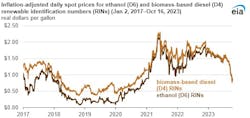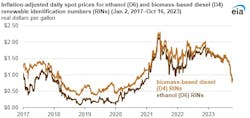EIA: Market prices for Renewable Fuel Standard credits are falling
The prices of ethanol and biomass-based diesel renewable identification number (RIN) credits, the compliance mechanism used for the Renewable Fuel Standard (RFS) program administered by the US Environmental Protection Agency (EPA), have each dropped by more than a third between Sept. 1 and Oct. 16, according to data from the US Energy Information Administration (EIA).
To increase biofuels use, EPA sets annual targets, called Renewable Volume Obligations (RVOs), for the amount of renewable fuels that must enter into the US fuel supply. Petroleum refiners and importers of motor gasoline and diesel comply either by blending biofuels into petroleum-based fuels or by purchasing RIN credits. Ethanol production generates D6 RINs that satisfy the total biofuel obligation. Biomass-based diesel production generates D4 RINs that satisfy the biomass-based diesel, the advanced biofuel, and the total biofuel obligations.
Biomass-based diesel D4 RINs typically trade at higher prices than ethanol D6 RINs because they meet more RVOs. This year, the two RIN prices have moved close together, as the RVOs for biomass-based diesel and advanced biofuels were set significantly below production trends, meaning the industry will easily meet the RVOs and pushing down RIN credit prices.
In general, RIN credit prices are driven by two main factors: biofuels production costs, which are heavily influenced by feedstock prices, and the RFS levels set by EPA. On June 21, 2023, EPA set the RVOs for 2023–25 below biofuel production trends, putting downward pressure on prices over the summer. However, higher raw material (production) costs offset the downward pressure on prices, delaying the price declines until September, according to EIA.
“RIN prices dropped in September as biofuel production costs declined and production levels exceeded the RVOs. Biofuel production costs, primarily the price of feedstock soybean oil, generally declined from January through May 2023, reducing RIN prices during that period. Soybean oil prices increased in June and July, largely offsetting the downward price pressures from the RFS and delaying the fall in RIN prices. As soybean oil prices eased in September and October, RIN prices also came down,” EIA said.

